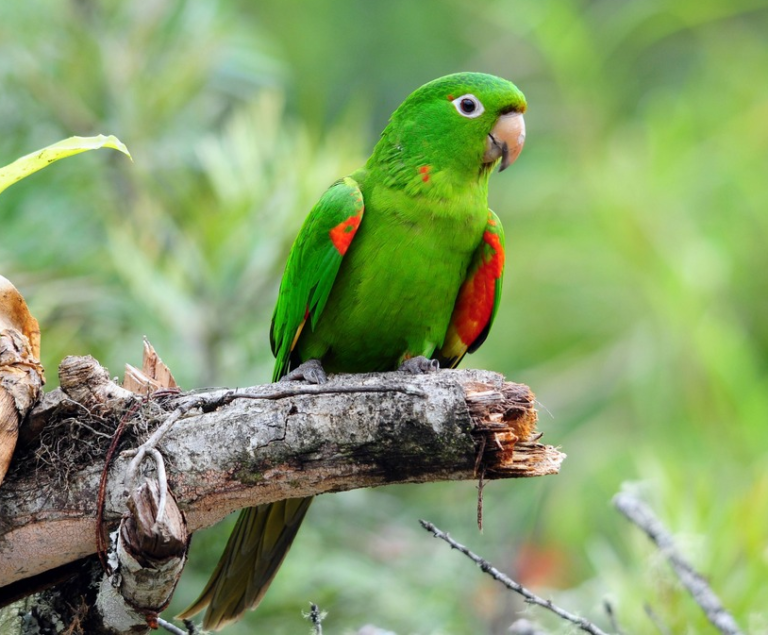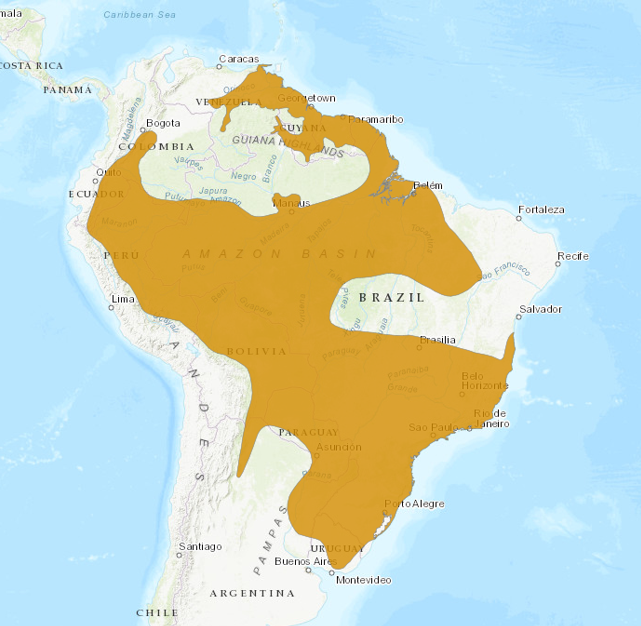Birdfinding.info ⇒ Common throughout most of its range. Especially numerous across central and southeastern Brazil, where it is a familiar bird of farms, towns, and cities, including Belo Horizonte, Rio de Janeiro, and São Paulo. The Buenos Aires population is abundant in many parts of the city, including the Costanera Sur. In Florida, it has been seen most consistently in South Beach (e.g., South Pointe Park), and regularly joins mixed parakeet flocks elsewhere in metropolitan Miami.
White-eyed Parakeet
Psittacara leucophthalmus
Eastern South America, in open woodlands, savannas, and edge habitats, including agricultural and urban areas.
Widespread east of the Andes from central Colombia, eastern Venezuela (including Isla Margarita), and the Guianas south to central Argentina (to Catamarca, Santa Fé, and Entre Ríos) and Uruguay. Mostly absent from the Llanos of Colombia and Venezuela and the arid caatinga region of northeastern Brazil.
Its numbers appear to be increasing overall, and its range has expanded rapidly following the clearance of forest across most of Amazonia (where it formerly occurred much more locally).
It apparently colonized both Isla Margarita (of Venezuela) and Trinidad in the 2010s—but unclear whether this occurred naturally from mainland Venezuelan populations or through introduction.
In eastern Argentina, an introduced population in Buenos Aires City has grown enormously and spread along the eastern coast of Buenos Aires Province to Mar Chiquita.

Brazilian records by municipality. © WikiAves 2022
Introduced populations are also established in north-coastal Venezuela (Caracas and Maracay) and southeastern Florida (Fort Lauderdale to Kendall).
Identification
A large green parakeet with a pale ivory-colored or pinkish bill, striking red-and-yellow underwing coverts, and irregular flecks of red on the head neck and breast. Conspicuously misnamed, as its eyes are actually brownish with bare white orbital skin—a feature it shares in common with most other Psittacara parakeets, some of which have much paler eyes.
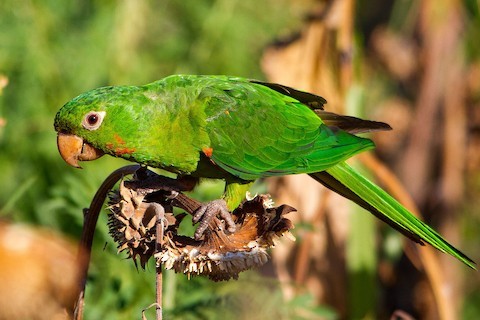
White-eyed Parakeet. (Parque Jambeiro, Campinas, São Paulo, Brazil; April 4, 2016.) © Laerte Cardim

White-eyed Parakeet, ventral view in flight, showing distinctive underwing pattern. (Campinas, São Paulo, Brazil; August 12, 2013.) © José Carlos
The best diagnostic feature of adult White-eyes is the underwing pattern—red on the leading edge of the primary coverts, bordered by a vivid-yellow bar on the greater coverts, usually also with a strong yellow cast on the flight feathers, such that the underwing appears mostly yellow with a red shoulder and green secondary coverts.

White-eyed Parakeet with typically sparse, irregular red speckling. (Porto Jofre, Mato Grosso, Brazil; September 28, 2018.) © Matthew Grube
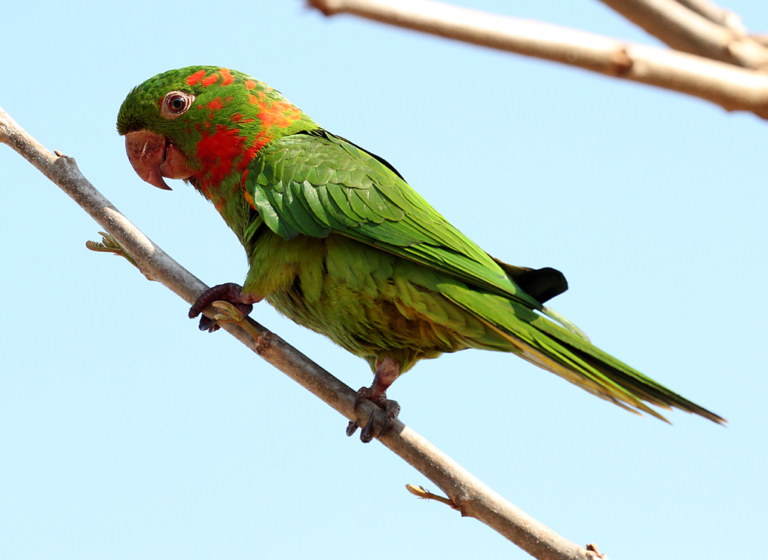
White-eyed Parakeet with unusually extensive red patches on the head. (São Sebastião da Grama, São Paulo, Brazil; September 25, 2016.) © Luiz F. Pereira
Immatures typically have all-green plumage, and lack the adults’ diagnostic underwing pattern or show it incompletely, and are therefore more easily confused with other species.
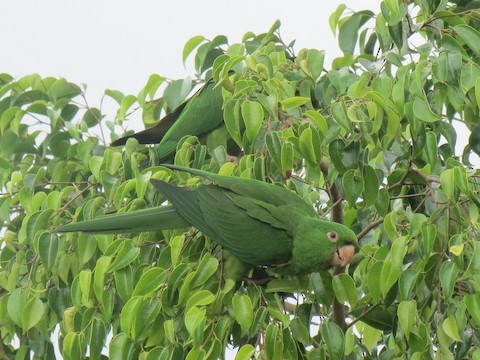
White-eyed Parakeet, immature. (Pindamonhangaba, São Paulo, Brazil; September 1, 2019.) © Vitor Suzuki de Carvalho

White-eyed Parakeet, immature (below) and adult, ventral view in flight, showing difference in underwing coloration. (São Luiz do Paraitinga, São Paulo, Brazil; June 29, 2018.) © Marco Guedes
Notes
Polytypic species consisting of three recognized subspecies.
See below for comparisons of the White-eyed Parakeet with other Psittacara parakeets and the Red-shouldered Macaw.
Cf. Other Psittacara Parakeets. At middle elevations of the eastern Andes, White-eyed sometimes overlaps locally with Cordilleran and Mitred Parakeets. Outside its natural range, where introduced or escaped, White-eyed could overlap with other similar species. In southern Florida, White-eyed flocks with Mitred, Red-masked, and possibly other Psittacaras.
Adult Cordilleran, Mitred, and Red-masked all have more red on the face than White-eyed, and lack White-eyed’s strong yellow bar on the underwing coverts. Immatures of all Psittacaras are essentially all-green without distinct underwing patterns, and may be indistinguishable until they begin to show adult characteristics.
In the Caribbean, both Cuban and Hispaniolan Parakeets have the same general appearance as White-eyed, including red on the leading edge of the underwing coverts. The Cuban Parakeet in particular is nearly identical to White-eyed, including irregular flecks of red on its head and breast—but unlike White-eyed, Cuban actually has a pale eye. In all cases, adult White-eyed’s strong red-and-yellow covert bars are its most reliable diagnostic feature.
Cf. Red-shouldered Macaw. Across most of its South American range, the White-eyed Parakeet is most likely to be confused with the Red-shouldered Macaw, which is approximately the same size, has red underwing coverts, has a parakeet-like voice, and occurs in some of the same habitats. If seen well, the macaw can be identified by its bicolored bill and extensive bare white facial skin around the base of the bill.
Seen in flight at a distance, the two species appear very similar, but details of their underwing patterns differ. White-eyed Parakeet has red-and-yellow coverts beyond the wrist, but the coverts from the wrist to the body are green. Red-shouldered Macaw has red coverts all along the leading edge of the underwing, on both sides of the wrist, with no yellow on the coverts.
More Images of the White-eyed Parakeet
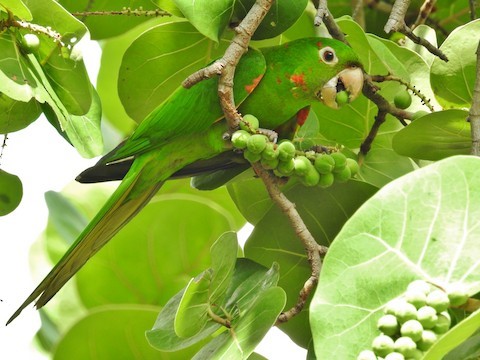
White-eyed Parakeet. (South Pointe Park, Miami Beach, Florida; July 1, 2016.) © Héctor Moncada
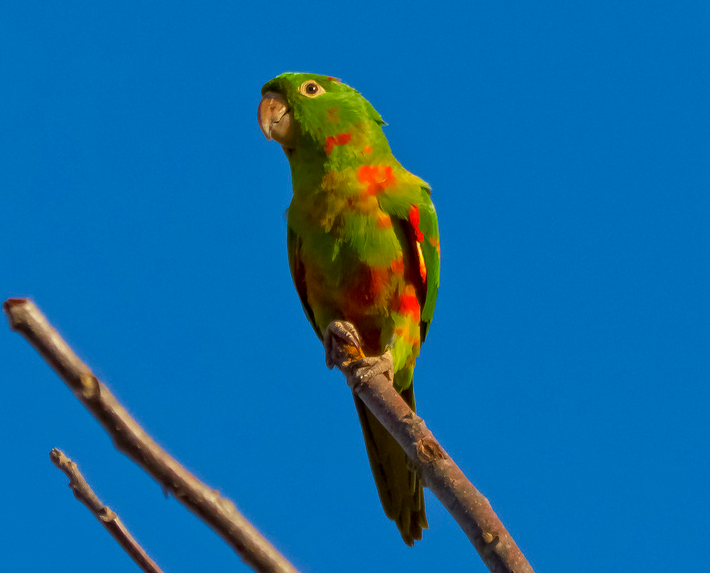
White-eyed Parakeet with unusually extensive red patches on the underparts. (Sacramento, Minas Gerais, Brazil; August 18, 2012.) © Celso Queiroz
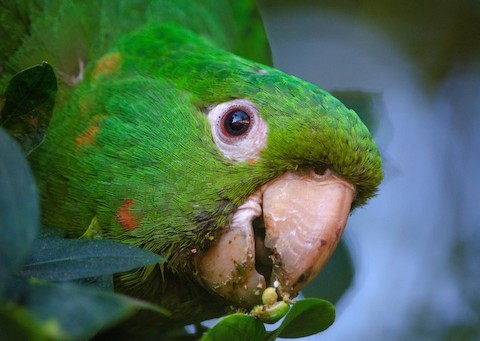
White-eyed Parakeet. (Bosques de Palermo, Buenos Aires City, Argentina; January 24, 2021.) © Iván Eroles

White-eyed Parakeet. (Campinas, São Paulo, Brazil; June 2, 2012.) © Rodrigo Goes
References
Ascanio, D., G.A. Rodriguez, and R. Restall. 2017. Birds of Venezuela. Christopher Helm, London.
BirdLife International. 2016. Psittacara leucophthalmus. The IUCN Red List of Threatened Species 2016: e.T22685682A93083034. https://dx.doi.org/10.2305/IUCN.UK.2016-3.RLTS.T22685682A93083034.en. (Accessed March 9, 2022.)
de la Peña, M.R., and M. Rumboll. 1998. Birds of Southern South America and Antarctica. Princeton University Press.
eBird. 2022. eBird: An online database of bird distribution and abundance. Cornell Lab of Ornithology, Ithaca, N.Y. http://www.ebird.org. (Accessed March 9, 2022.)
ffrench, R. 2012. A Guide to the Birds of Trinidad & Tobago (Third Edition). Cornell University Press.
Forshaw, J.M. 2010. Parrots of the World. Princeton University Press, Princeton, N.J.
Juniper, T., and M. Parr. 1998. Parrots: A Guide to Parrots of the World. Yale University Press.
Kirwan, G.M., A. Levesque, M. Oberle, and C.J. Sharpe. 2019. Birds of the West Indies. Lynx Edicions, Barcelona.
McMullan, M., and T. Donegan. 2014, Field Guide to the Birds of Colombia (Second Edition). Fundación Proaves de Colombia, Bogotá.
Ridgely, R.S., and P.J. Greenfield. 2001. The Birds of Ecuador, Volume II: Field Guide. Cornell University Press.
Schulenberg, T.S., D.F. Stotz, D.F. Lane, J.P. O’Neill, and T.A. Parker. 2007. Birds of Peru. Princeton University Press.
van Perlo, B. 2009. A Field Guide to the Birds of Brazil. Oxford University Press.
WikiAves. 2022. Periquitão, http://www.wikiaves.com.br/periquitao. (Accessed March 9, 2022.)
Xeno-Canto. 2022. White-eyed Parakeet – Psittacara leucophthalmus. https://xeno-canto.org/species/Psittacara-leucophthalmus. (Accessed March 9, 2022.)
